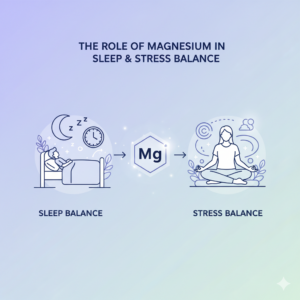Article Categories

Navratri Fasting Guide 2025: Dietitian Tips for Healthy Upvas
Discover expert dietitian tips for a healthy Shardiya Navratri 2025 fast (Sep 22-Oct 2). Blend sattvic traditions with science for energy, hydration, and mindful eating—perfect for global devotees balancing devotion and wellness.

Iron-Boosting Foods Every Woman Should Know About
Iron is essential for energy, immunity, and overall well-being, yet many women struggle with deficiency. Discover the top iron-rich foods, how to enhance absorption, and practical tips to keep your energy levels high.

The Role of Magnesium in Sleep & Stress Balance
Magnesium plays a quiet yet powerful role in calming the body and mind. This essential mineral supports melatonin production, relaxes muscles, and balances stress hormones — all of which promote deeper, more restorative sleep. Modern diets and stress can easily deplete magnesium levels, leading to restlessness, anxiety, and poor sleep quality. Discover how magnesium-rich foods and smart intake timing can help you sleep better and feel calmer naturally.

Samak Rice Idli
Light, fluffy, and gluten-free — Samak Rice Idli is a wholesome twist on the traditional idli, perfect for fasting days or a gentle, gut-friendly meal. Made with barnyard millet and curd, it’s rich in fibre, easy to digest, and a great source of plant-based protein. Ideal for post-festive recovery or a clean, nourishing breakfast.

Magnesium-Rich Foods to Reduce Stress Naturally
Stress is something we all deal with daily—whether it’s work pressure, family responsibilities, or simply the fast pace of modern life. While we often turn to caffeine, sugar, or quick fixes to cope, nature already provides us with a powerful stress-buster: magnesium.

Why Portion Control is More Important Than Counting Calories
When it comes to weight management and healthy eating, two common strategies often come up: counting calories and controlling portion sizes. While calorie counting has long been a popular method, research increasingly shows that portion control is more practical, sustainable, and beneficial for long-term health. Understanding the science behind portion sizes and how our bodies respond to food can help people make healthier choices without the stress of tracking every single calorie

The Ultimate Guide to Mouth Ulcers and Canker Sores
Mouth ulcers are a common yet painful problem affecting 20% of people. This comprehensive guide from FoodnWellness dietitians explores the root causes—like vitamin deficiencies, stress, and food sensitivities—and offers evidence-based remedies for immediate relief and long-term prevention. Learn how to stop the pain and break the cycle of recurrent canker sores.

Rice Appam
Rice Appam is a light, lacy-edged South Indian pancake made from fermented rice and coconut batter. Soft at the center and crisp at the edges, it’s naturally gluten-free and easy to digest. Fermentation enhances both flavor and nutrition, making it a wholesome choice for breakfast or dinner when paired with stew, kala chana curry, or sambar.
Why Waist Circumference Is a Critical Health Marker | Know Your Risk
Waist circumference isn’t just about how your clothes fit — it’s one of the most telling indicators of your metabolic health. Excess fat around the abdomen, especially visceral fat surrounding internal organs, is strongly linked to higher risks of heart disease, type 2 diabetes, and certain cancers. Unlike overall body weight, waist size reflects where fat is stored, which plays a bigger role in disease risk. Measuring your waist at the level of your belly button can reveal if you’re in the healthy range or need to take action.

Magnesium & Fertility: Why This Mighty Mineral Matters for Reproductive Health
Magnesium is a fertility powerhouse—balancing hormones, boosting ovulation, and improving sperm health. Yet, 50% of adults are deficient! Discover how this “master mineral” enhances conception, top food sources, and smart supplementation tips backed by the latest research.

